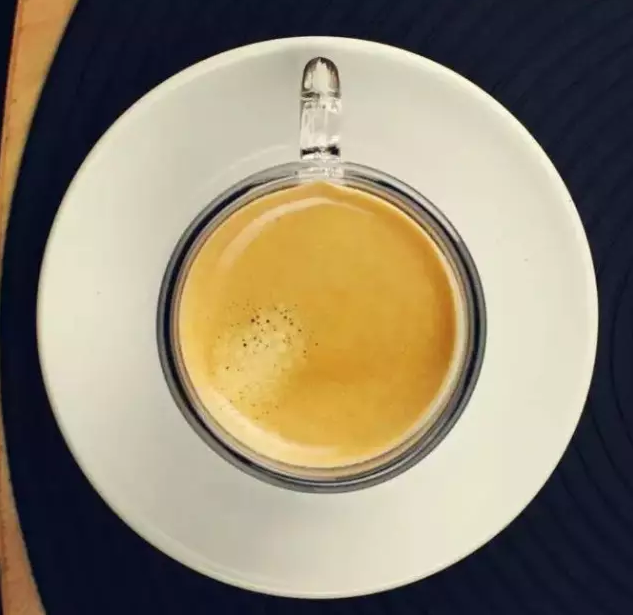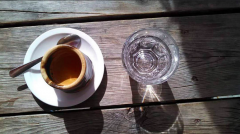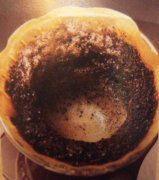If the coffee grindability is controlled, what is the standard of gold cup extraction and gold cup theory coffee grindability?

Professional coffee knowledge exchange more coffee bean information please follow the coffee workshop (Wechat official account cafe_style)
How to judge and set the grinding degree of espresso
The proportion of Gold Cup coffee defined by SCAA (American Fine Coffee Association) and SCAE (European Fine Coffee Association) must hold the extraction rate of coffee at about 20%, while TDS is about 1.1% Mel 1.3%.
For Drip Filter drip brewing, how to extract the best coffee flavor is controlled by two variables: the extract of coffee powder and the concentration in a cup of coffee, and these two variables had the so-called "Coffee Gold Cup" golden cup coffee theory as early as 1960.
According to the definition of Gold Cup Standard by SCAE (European Coffee Association): "Coffee coffee is brewed with 1000ml water, 50ml 60g coffee powder, 92 °C-96 °C hot water". The coffee is brewed at the "bull's-eye" position of the optimum extraction rate (Extraction) and concentration (Strength Concentration), that is, "Gold Cup".
First of all, each coffee can be extracted, the maximum is about 30% (that is, 70% of xylem cannot be extracted), that is, 10g coffee powder has up to 3G coffee soluble extract, while a cup of delicious coffee, the best extraction rate of coffee, that is, 60% of the maximum soluble matter of 30% coffee is the most suitable extraction, which is less than 60% (less than 18%), that is, insufficient extraction, coffee flavor will show incomplete flavor. On the other hand, if the extraction rate is more than 70% (the extraction rate is more than 22%), the coffee will be overextracted and the coffee will show bitter, spicy and bad taste.
Therefore, the best extraction rate of coffee is 18% Murray 22%.
This 18 Murray 22% Mustang 30% * (60 Murmel 70%), that is, the maximum extractable rate of coffee is 30%, extraction 6 Murray 7 is the best coffee flavor, why don't I directly write 18 Murray 22%, and around 60% of 30%, 70%, is that when we are brewing a cup of coffee, we can imagine how to extract the best flavor from the maximum coffee extract.
In other words, 10 g coffee powder can extract up to 30% (3G) of coffee soluble matter, but we expect the best extract 18% Murray 22% (1.8 Murray 2.2 g).
In addition, how much hot water these extracts will dissolve in? this is the coffee concentration. The optimum coffee concentration is between 1.0% and 1.5%, which is less than 1.0%. It is better to drink boiled water. If the coffee concentration is too strong (for drip-filtered coffee), it will have a bad taste. The best Gold Cup concentration of drip filter coffee is 1.2% Murray 1.45%. Too light or too strong coffee concentration is not good taste. American flavor: the concentration of coffee is relatively light, so the concentration of TDS for a cup of American coffee is about 1.2%. European flavor: generally speaking, the concentration of European coffee is a little stronger, so the concentration of TDS for a cup of European coffee is about 1.3 Murray 1.45%.
Therefore, SCAE (European Fine Coffee Association) defines the target position of the standard Gold Cup, which is related to the extraction rate and concentration, that is, the amount of coffee powder is as follows:
Scheduled to brew at least and maximum
Coffee quantity ml coffee powder quantity g
240 13 18
300 16 23
360 19 29
400 21 31
500 27 38
600 32 46
800 43 62
1000 54 77
Determine the amount of coffee to be booked and set the upper and lower limits of coffee powder from the control table, how to achieve the best extraction rate from 30% extraction rate to 22%, and the coffee brewing concentration is just at 1.2% Mel 1.45%, just like how to throw a good ball. After brewing a cup of Gold Cup coffee, the above basic powder and brewing amount are determined, whether it can reach the best 18% Murray 22% optimal extraction rate, while the concentration falls to 1.2% Murray 1.45%, which involves the extraction rate, coffee grinding thickness, water temperature, filter medium (affecting water retention time). Wait for mutual cause.
According to SCAE, the controlling factors of making a good cup of coffee include the following five items; no matter how you brew coffee, these five principles must be mastered.
Mastery of extraction time Contact time: using various brewing methods, in order to extract 22% of the extraction rate in the better extraction time, it is important to control the grindability and water temperature of coffee.
It is necessary to master Temperature of the water:92 °C murf 96 °C to start boiling water temperature, too high or too low initial water temperature may not be appropriate.
Disturbance of coffee powder Turbulence in the process of brewing: disturbance is to get the proper extraction rate, such as plug air stirring, hand flushing water column flushing strength and so on are all necessary to achieve the extraction.
Pre-impregnated moist coffee powder Wettability: hand-made, espresso, American style has the wetting stage before brewing, this stage wetting water is per gram of coffee powder, 2ml water pre-soaking, soaking time is about 30sec. Of course, the roasting state of coffee beans has different pre-soaking and wetting states, and this part of the hand washing can be well controlled.
Uniform brewing Uniform Dispersion: the brewing process allows the water to pass evenly through each coffee powder, while maintaining the same water temperature from the beginning to the end. Water extraction is important. For example, espresso emphasizes the uniform temperature and pressure of the brewing water, and this is the case with a stable water column by hand.
Coffee brewing method:
French press French pressure
Percolator mocha pot
Drip Filter trickle filtration
Syphon Saifeng siphon
Pressurised Infusion (Espresso) semantic concentration
As for the grinding thickness of coffee powder:
French pressure: each coffee is ground into 100Muth300 coffee powders, about 0.7mm powder in diameter, that is, about the size of No. 2 granulated sugar.
Filter: each coffee is ground into 500 Murray 800 coffee powder, about diameter 0.5mm powder, that is, about the size of coffee with sugar particles.
Saifeng: each coffee is ground into 1000 Murray 3000 coffee powder, about diameter 0.35mm powder, that is, about the size of food refined salt particles.
Espresson: each coffee is ground into 3500 coffee powders, about the diameter of 0.05mm powder, that is, about the size of flour particles.
PS. SCAA standard cup timing coffee powder grinding, 70mur75% pass the uniformity of the standard sieve # 20 (0.85mm), about a little thicker than the French press.
In addition, SCAE provides the concept of coffee brewing process and brewing time of different grinding thickness:
Wetting: at this time, put hot water into the coffee powder to wet the coffee, let the coffee extract dissolve, the amount of water infiltration is about twice the amount of coffee powder, and the infiltration time is about 30sce.
Brewing stage Water Cycle: at this time, because the coffee powder thickness has different time to let the water contact with the coffee powder, and dissolve the coffee extract.
a. French pressing: powder coarse, infiltrating about 3 Murray 5 min
b. Dripping follicle type: the cooking process is about 1 Mel 3 min
C. Syphon: the cooking process is about 40 sec.
D. Espresso: extract 30cc espresso in 30 seconds
The latter part of the extraction: at this time, the coffee has extracted more than 50% of the extractable matter, that is, 60% of the coffee soluble extract of 70% of the coffee is extracted for the optimum extraction and the amount of water is adjusted to reach the optimum coffee concentration is between 1.0 and 1.5%.
Coffee grounds after extraction: the water content in the coffee grounds is about 2 times that of the original coffee powder (hand-brewed type).
Reference to the weight of some coffee pounds:
Coffee beans: about 6 murmurs, 7 beans for 1g
Hario Syphon measuring spoon: 1 flat spoon 8 Muhami 9g
Hario V60 measuring spoon: 1 flat spoon 14Murray 15g
Coffee beans (after roasting): 0.38 Murray 0.43 g / cm ^ 3
Coffee powder: 0.44murmur0.48g / cm ^ 3
A coffee bean with long axis 12mm, short axis 8mm and high 5mm semi-ellipsoid is roasted. It is said that the coffee extraction is related to the surface area. The surface area of the above coffee is 1.4cm ^ 2.
ExtractMOJO issued by TDS and George Howell Coffee company.
ExtractMojo is not a new concept. He just continues the Gold Cup principle of SCAE and makes the theory and practice more convenient. For many people, this set of Gold Cup theory, which was used to examine the quality of follicle coffee in the 1960s, is no stranger. But I must admit that this is the first time I have seriously understood the principle, re-took out the extraction theory, and examined my follicle products. And got shocking results.
Coffee under the Gold Cup framework must maintain an extraction rate of 22% (Extraction) and a concentration of about 1.3% TDS (Strength). This is a relationship between the extraction rate and concentration that enables coffee to balance the interpretation of flavor. A coffee bean has about 30% of the soluble substance (the remaining 70% is an insoluble structure, including xylem); the standard extraction rate of Gold Cup is set at 20%; if it is too low, it is due to underextraction (under developed), which leads to flavor imbalance; if it is too high, it is bitterness caused by excessive extraction (Bitter). Strength means that the same soluble substance in the coffee is washed out as a percentage of the coffee solution. The higher the percentage, the stronger the coffee (strong) and vice versa (weak). After understanding these two terms, we have to work hard to make coffee to the goal of Extraction=20% and TDS=1.3%.
To achieve this goal of Extraction=20% and TDS=1.3%, Gold Cup has a recommended water-powder ratio, which is about water: coffee= 17:1. The convenience of ExtractMOJO is that you can fix the amount of powder (ground coffee), the amount of water used for cooking (brew water), or the capacity after the cup (desired yield), one of the three parameters, to calculate how much the remaining two should be. For example, if you are going to brew a cup of coffee with a full cup capacity of 240cc today, after you fill in the number in this field, ExtractMOJO will advise you to use 271.69ml 's water with 15.19g of coffee powder (the software will estimate the average water absorption of coffee powder). First fix the water temperature (suppose 205F), take the TDS value of the cup of coffee after brewing, and then input the software to get the landing point of brewing coffee, and then correct it. If the TDS is too high, you can thicken the powder or shorten the extraction time, and vice versa. Follow the data a few more times, and you will soon be able to catch your Gold Cup cooking parameters.
Of course, if you want coffee strong (stronger) or light (weaker), you can also adjust the setting. After adjustment, the cooking parameters will follow. This is where ExtractMOJO is convenient. You don't need to do the math with a computer, just throw the data in, follow the operation, and then correct it according to the actual TDS value. In principle, Extraction=18--22%, TDS=1.3--1.6% is an acceptable range.
I measured the coffee filter in the store once. It was found that the brewing of Clover, due to the deviation of the previous concept, used too much powder, which led to the increase of TDS to improve the intensity of coffee, but ignored the performance of extraction rate, and made the coffee fall in the range of underdeveloped and rich (Strong/Underdeveloped; TDS=1.7, Extraction=11%). This cooking method, in addition to a waste of coffee powder, resulting in insufficient extraction rate, but makes the flavor of the producing area is not obvious. It is urgent to use the recommended amount of powder to find new grinding, extraction time, and filter mesh. If business capacity is taken into account, I can't use the four minutes recommended by Gold Cup to make coffee, so I have to fine-tune the grinding to shorten the brewing time. In addition, the coarse filter (70 micorn) is more suitable for cooking Gold Cup than the fine filter (100micorn).
With the help of the software, it took about one night for the extraction parameters to be sorted out, including the brewing settings for medium, light and deep-roasted coffee. Of course, you can ignore the gold cup model, but after testing the golden cup of coffee, I found a few significant differences compared to the coffee I made before:
The flavor of the producing area is more obvious.
Sweetness becomes higher
Cleanliness becomes higher
Throat rhyme lengthening
Then, interestingly, I put the amount of powder in the earbag into the software and boiled it according to the recommended amount of water (200cc), but coincidentally I got the combination of Gold Cup's Extraction=20% and TDS=1.3%, which I didn't expect.
Fifty years after the invention of the principle, or five years after I opened the shop, I seriously discussed the principle of gold cup and applied it to the store, which is very sorry to my coffee and customers. I admit that in many cases, taste should be the key to the final decision of the process. However, sometimes the convenience provided to us by the existing scientific principles is ignored, which increases the pain and uncertainty in the process of exploration. This software gives me a new understanding of how Gold Cup works, and because of the convenience of the software, I can adjust the existing process to provide mojocoffee enthusiasts closer to perfect coffee. This was an unexpected harvest when I first discussed it with Scott Rao.
Ps. Please give me a few days, let me update the corresponding gold cup parameters of several commonly used cooking methods, including thickness sample, extraction temperature, water quantity, powder quantity, and time, etc., and then update them to you.
.
Important Notice :
前街咖啡 FrontStreet Coffee has moved to new addredd:
FrontStreet Coffee Address: 315,Donghua East Road,GuangZhou
Tel:020 38364473
- Prev

The relationship between coffee extraction and grinding degree-what is the change in taste and flavor of coffee with different grinding degree?
Professional coffee knowledge exchange more coffee bean information please pay attention to the coffee workshop (Wechat official account cafe_style) coffee bean grinding fineness how to judge and set the Italian espresso extraction speed: the oxidation rate is proportional to the surface area, and the extraction of substances in coffee is also proportional to the surface area, that is to say, the finer the grinding, the faster the extraction speed.
- Next

How to use taste to adjust the thickness and proportion of coffee grinding?
Professional coffee knowledge exchange more coffee bean information please pay attention to the coffee workshop (Wechat official account cafe_style) coffee bean grinding fineness how to judge and set the grinding degree of espresso whether the taste extracted is balanced; sweetness, acidity, and baked taste ratio? If the extracted taste is balanced, but the taste is not your preference, you need to use it instead.
Related
- What is the Philharmonic pressure? How to use Philharmonic pressure to make delicious coffee
- Why does a hand grinder have more fine powder than an electric grinder?
- In addition to the hot mom, what is the difference between the versions of EK43 | ditting and Mahdi ek43?
- What kind of equipment do you need to make coffee by hand? Introduction to novice starter cooking equipment tools
- Espresso needs to be ground how thick and thin scale entry Italian Coffee Machine Bean Grinder investigation and Grinding course
- How much does it cost to open a small private cafe? How much does it cost to learn coffee? How to operate it?
- The difference between the flavor characteristics of hand-brewed coffee and coffee maker is hand-brewed coffee really better than coffee maker? Can I use a coffee machine to make coffee beans by hand?
- The difference between 01 and 02 of hario v60 filter cup what is the difference between 01 and 02 filter cup opening and cooking flavor
- What's the difference between the smart cup and the French kettle? Which is better, the French kettle or the Smart Cup?
- What's the difference between a smart cup and a V60 filter cup? The difference between the taste of smart cup and hand-brewed coffee

